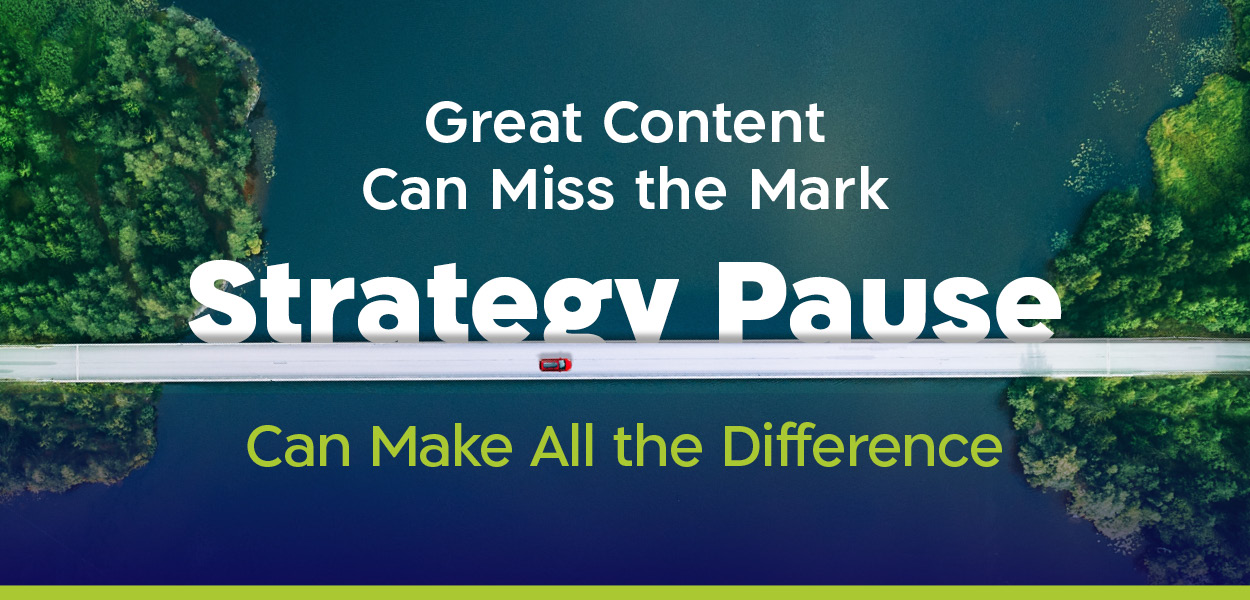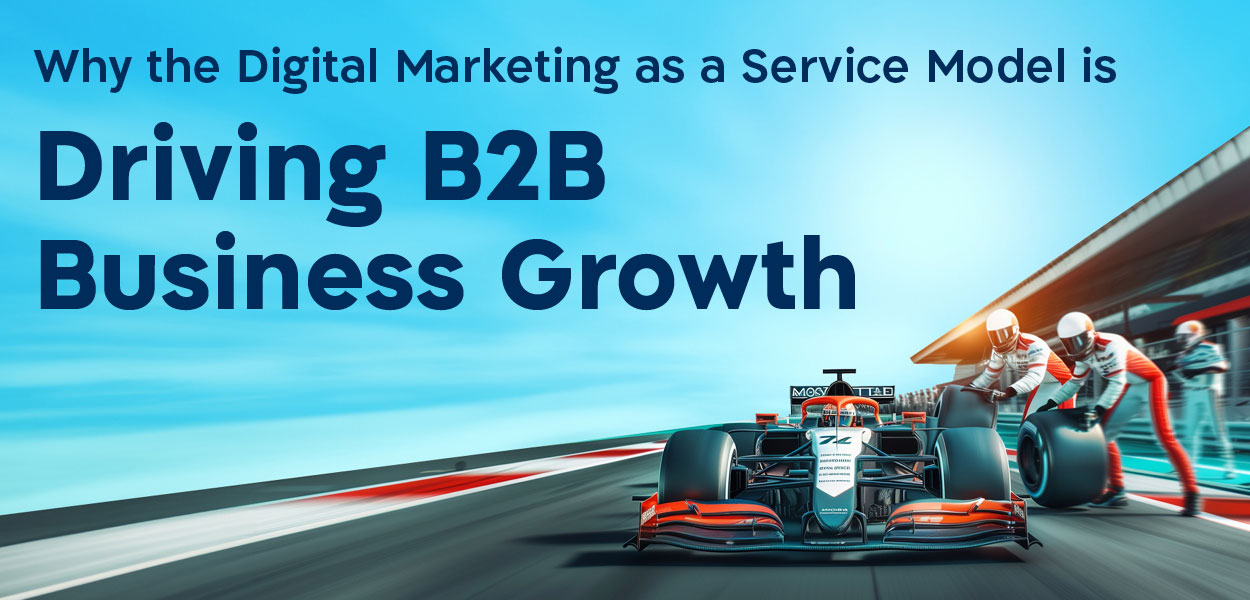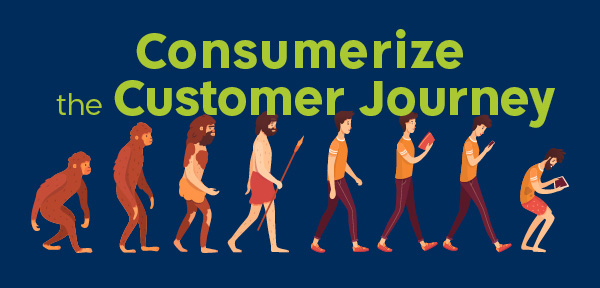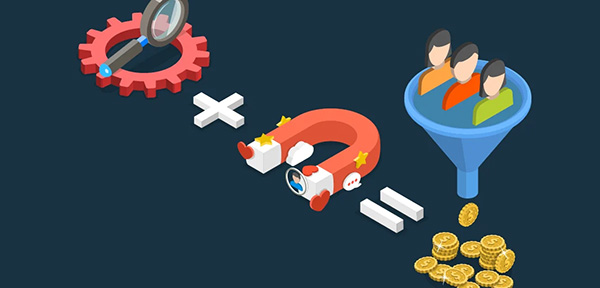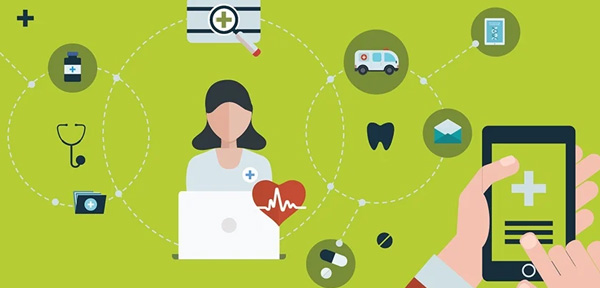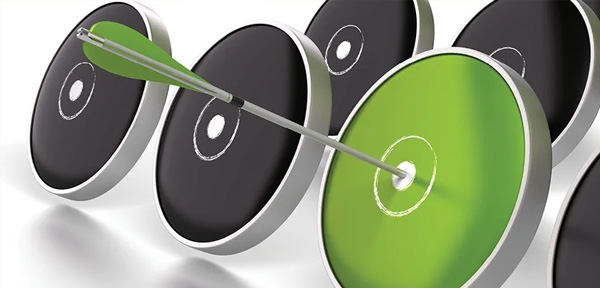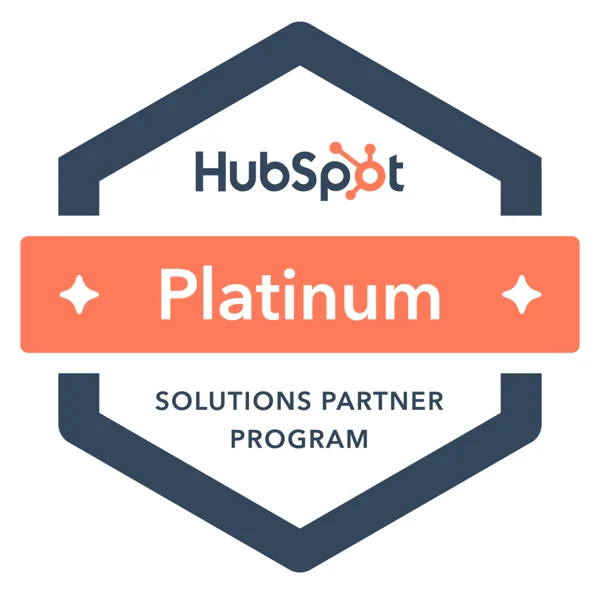The BL[OZ]
Even Great Content Can Miss the Mark and How a Strategy Pause Can Make All the Difference
By
Liron Ramot
, 22/09/2024
Digital marketing is essential for B2B companies to reach their target audience, generate leads, and stay competitive. Many lack the resources to handle it in-house, making outsourced digital marketing a valuable solution.
Why Often Misses the Mark?
Creating digital content that truly connects with your audience is no small feat. The landscape is crowded, the competition is intense, and audiences are more critical than ever. While many businesses pour resources into content creation, they find that their efforts do not translate into engagement or conversions. Most of the time, it's just a lack of alignment between content and the organization's overall business goals. Without a clear, strategic framework, content can become scattered, inconsistent, and ultimately ineffective. This is exactly why companies should consider stepping back to take a broader view. Rather than rushing ahead with the next campaign or content piece, a strategic pause to reassess and realign can be incredibly valuable. This is the essence of the discovery and study processes, a strategic approach that will build a solid foundation for your digital marketing campaign.
Understanding the Study Process
The primary aim of the Study process is to provide a focused analysis of your current digital marketing efforts. It’s about taking a step back and evaluating what’s working and what isn’t, allowing for strategic adjustments that enhance performance. This process is ideal for annual strategy reviews, specific campaign assessments, or when there’s a need to refresh the approach to your digital marketing.What It Achieves?
The Study process delivers actionable insights that help fine-tune your digital strategy. By concentrating on specific areas, such as target audience engagement, campaign effectiveness, or digital content performance, the Study process allows businesses to make data-driven decisions that improve ROI. It helps you understand where your content may be falling short and offers concrete steps to address these issues.How It’s Done?
- Initial Consultation: In-depth session to clarify your business’s current digital marketing objectives and identify the key areas that require attention.
- Targeted Research: Assessing the performance of specific campaigns, audience engagement metrics, and the effectiveness of your content in driving desired outcomes.
- Strategy Refinement: Adjust and optimize existing strategies based on findings.
- Implementation and Monitoring: Monitoring and tweaking the revised strategy as needed.

Exploring the Discovery Process
The Discovery process offers a broader, more comprehensive approach to digital strategy development. It’s designed for businesses that are launching new brands, undergoing a rebrand, or expanding into new markets. The Discovery process is about building a solid strategy that aligns with long-term business goals and keeps consistency across all digital channels. The Discovery process offers a deep dive into your brand’s identity, your market, and your audience. It provides a holistic understanding of your brand’s digital landscape. It uncovers opportunities for differentiation, identifies potential challenges, and sets a strategic direction that makes sure all digital efforts are aligned with your overarching business goals. One of the unique offerings of the Discovery process is the development of a visual language for your digital activities. This component ensures that your brand communicates consistently and effectively across all platforms, enhancing brand recognition and coherence, which is not typically included in the Study process. The goal is to develop a strategy that meets immediate needs as well as positions your brand for long-term success. This process is particularly beneficial for companies preparing for major changes, such as a new brand launch or market expansion.How It’s Done?
- Kick-off Meeting: Clarify goals and challenges.
- Comprehensive Research and Analysis: A thorough examination of the market, competitors, and internal capabilities. Key activities include identifying Buyer Personas, conducting a Competitive Digital Analysis, and performing a detailed SEO review.
- Digital Strategy Development: Based on the research insights, a full-scale digital strategy is formulated. This includes defining content pillars, creating a media plan, and developing creative visual guidelines that ensure brand consistency across all platforms.
- Presentation and Implementation: Once approved, the strategy is implemented, with ongoing support to ensure its success.

Why Discovery Is the Better Choice?
While both the Study and Discovery processes offer valuable insights and strategic direction, the Discovery process stands out as the more comprehensive and long-term solution. Here’s why Discovery might be the better choice for most businesses: Long-Term Strategic Value Discover aims to build a digital strategy that will serve your business for years to come, not just address immediate needs. By conducting thorough research and analysis, the Discovery process helps you create a strong, adaptable strategy that can evolve with your business. This long-term focus is particularly valuable in today’s fast-paced digital environment, where trends and technologies are constantly changing. Comprehensive Insights Unlike the Study process, which offers a more focused review, the Discovery process provides a holistic view of your digital strategy. This includes everything from a detailed SEO review to the development of creative visual language guidelines. These insights are crucial for making sure that all aspects of your digital presence. From content to design, everything is aligned with your brand's goals. Flexibility and Customization One of the key benefits of the Discovery process is its flexibility. The process can be adjusted to your specific needs - whether you’re launching a new product line, rebranding, entering a new market, or looking to create a unified visual identity for your campaigns. This customization helps make sure that your digital program is relevant, consistent, and effective. With the digital marketing arena being so fast-paced, it’s easy to get caught up in the rush to produce content and launch campaigns. Taking the time to reassess your digital strategy allows you to see what’s really working and where you might need to adjust course. It’s not simply about tweaking a campaign here or there, but rather making sure that every piece of content you create is connected to your broader goals and truly resonates with your audience. Whether you’re considering the focused approach of the Study process or the more comprehensive Discovery process, this strategic pause is crucial so your content doesn’t just reach your audience—it makes an impact.Why the Digital Marketing as a Service Model is Driving B2B Business Growth
By
Liron Ramot
, 17/06/2024
Digital marketing is essential for B2B companies to reach their target audience, generate leads, and stay competitive. Many lack the resources to handle it in-house, making outsourced digital marketing a valuable solution.
Digital Marketing as a Service (DMaaS) is a model that works
As an on-demand model, DMaaS allows your company to access a wide range of digital marketing expertise, tools, and resources without hiring and maintaining an in-house marketing team. While digital marketing toolboxes, tactics, and strategies differ according to client needs, they frequently comprise smart content, webinars, outreach and Account-Based Marketing (ABM), Search Engine Optimization (SEO), sponsored campaigns, and marketing automation to reach target audiences and drive traffic or conversions.4 great reasons why DMaaS makes sense for your B2B business
- Access top-tier talent without the overhead costs associated with traditional hires Budget constraints and HR challenges may be standing in the way of hiring an in-house digital marketing manager. DMaaS offers a cost-effective solution, allowing your company to alleviate the burden of recruitment, training, and retention, freeing up your resources to focus on your core business operations.
- Effectively navigate the complex digital landscape Tap into the expertise of seasoned professionals who possess a comprehensive understanding of digital marketing strategies, tactics, and execution skills that can help you achieve your marketing objectives.
- Adapt to changing market conditions Your business has to constantly adapt to market needs and business growth. DMaaS has built-in flexibility, allowing your business to scale up or down, based on your changing needs and budget.
- Set goals, measure results & change the game plan as needed In the dynamic world of digital, the goalposts are constantly changing. By setting key performance indicators (KPIs) and using accessible analytics tools such as those available in HubSpot, you can easily track the success of your marketing campaigns, optimize strategies as needed, and demonstrate the value of using DMaaS services.

Follow the yellow brick road
As a global B2B marketing expert, OZ has spent years building a strong reputation. Digital trends may come and go, but dedication, commitment to success, experience, and professionalism never go out of fashion. At OZ, we believe that long-lasting partnerships are based on deep listening, understanding, and transforming your goals into measurable results. That’s why many of our clients stay with us when they move companies, and why many clients come to us by word of mouth.Your dedicated digital account manager will be your work BFF
With OZ, your account will be managed by a dedicated digital account manager backed by a multidisciplinary team with expertise in every aspect of digital marketing, and more. Your OZ manager is always backed up by a team comprising a graphic designer, strategist, and content writer. Your OZ manager becomes an integral part of your marketing team, offering full commitment and dedication to your company's goals. It's not just one person, but an entire team of digital experts working behind the scenes to drive your digital marketing success. Every member of the OZ team brings with them a high standard of professionalism and expertise gained from working with numerous B2B companies across various industries.
Boost your bottom line
DMaaS enables you to reach and engage with your target audiences effectively, measure the success of your campaigns with precision, and adapt your strategies in real time based on insights and feedback. It’s there to act as a driving force in your marketing strategy, enabling you to access the resources and expertise required to enhance your brand visibility, attract and retain customers, and drive sustainable growth.Why HubSpot and ABM go together like hummus and pita?
By
Liron Ramot
, 22/01/2024
Discover the powerful synergy between HubSpot's Inbound Marketing and Account-Based Marketing (ABM) in our blog. Inbound sets the foundation for a robust ABM approach, attracting a broader range of prospects. Learn how HubSpot's ABM tools facilitate quick strategy setup, collaboration, attraction of high-value accounts, and effective tracking.
Inbound Marketing
Attracts customers by creating valuable content and experiences tailored to them. It’s about building meaningful relationships with consumers, prospects, and customers.Account-Based Marketing
A B2B strategy in which marketing and sales work together to create personalized buying experiences for a select set of high value companies.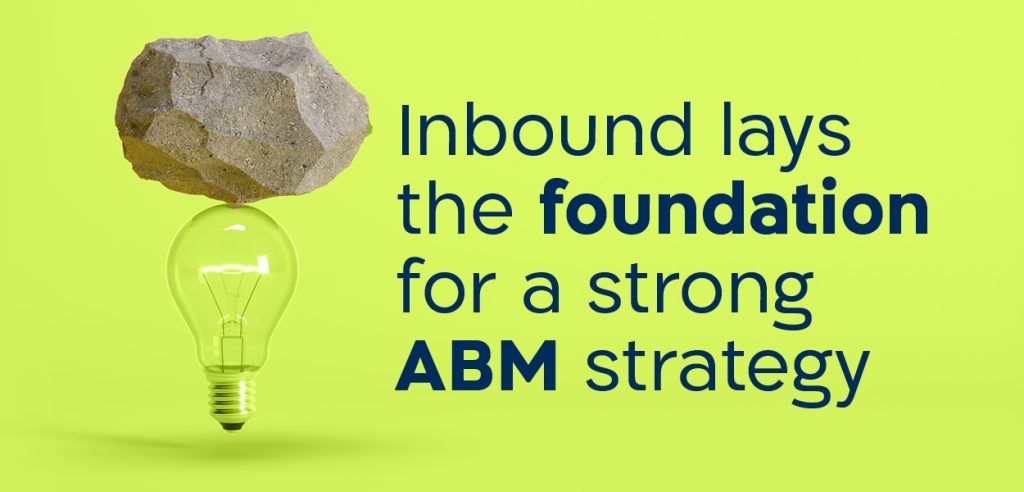
Inbound lays the foundation for a strong ABM strategy
According to HubSpot, inbound marketing helps you attract contacts associated with your target accounts. ABM accelerates the flywheel (the cyclical marketing funnel comprising attract, engage, and delight) so you can win and delight your target accounts by providing a standout customer experience. By using inbound, you’re able to carry out highly-targeted allocation of the most relevant resources to your high-value accounts. As a B2B marketer, by using this combined approach you can attract a broader group of prospects than you would if you were only using one method.Double up and deliver value
Your carefully crafted content has a two-for-one value. You can create and use content that serves both your ABM and inbound strategy. As an example, once you’ve created a personalized case study for a target account, you can also share on your website.Leverage account-based marketing tools
HubSpot’s ABM tool makes it easy to implement ABM and inbound strategies in a complementary way. Its CRM platform connects all of your sales and marketing data and allows enables customer-centric automation and personalization. It makes it easy to use data to segment and target your accounts and marketing automation to nurture your buyers or buying committee and hand over your leads to sales.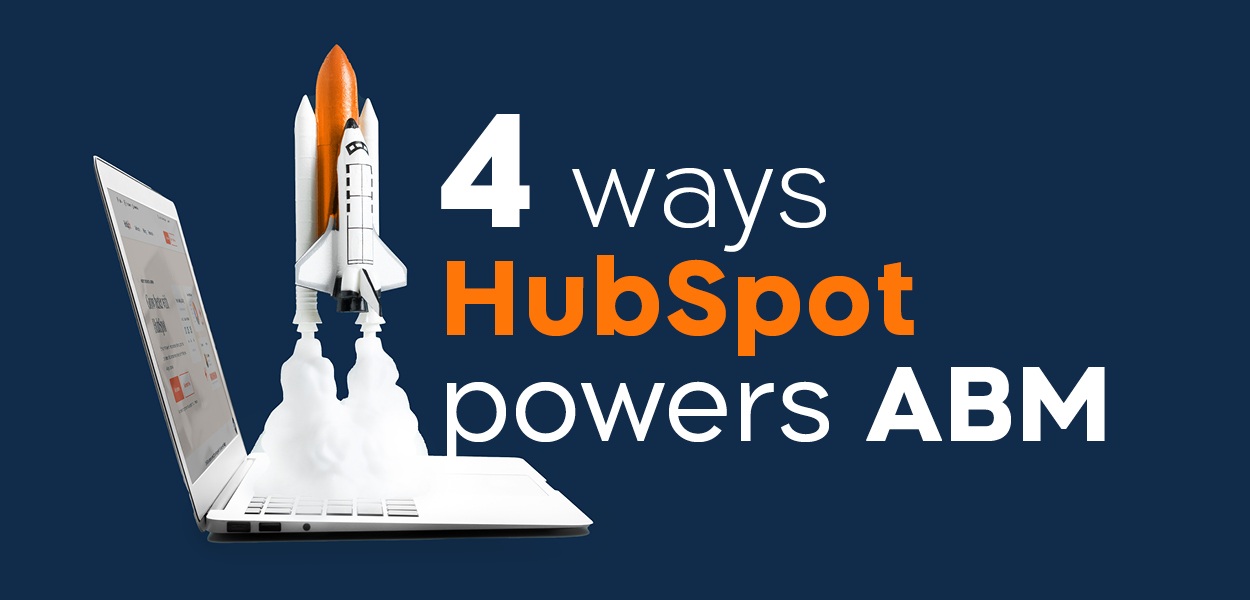 1. Set up ABM strategy quickly and smoothly
1. Set up ABM strategy quickly and smoothly
- Use workflow templates to define your ideal customer profiles and identify good-fit target accounts
- Set up default properties to tag accounts and buying roles
- Leverage AI-powered recommendations of target accounts
- Use shared tools that unite your teams around the same data in the same place
- Use the Target Accounts feature to obtain a bird’s eye view of progress across all target accounts
- Use Slack to support high-value target accounts, post KPIs, and share notes
- Personalize content and tailor how you engage with stakeholders within an account
- Use account-level targeting in LinkedIn Ads integration to target companies by account status or tier
- Deepen your relationships over time & build connections with stakeholders within each account
- Use the account overview feature to understand what’s happening at an account level
- Employ out-of-the-box ABM reporting dashboards to get a higher-level view
- Obtain a higher level view using company scoring to identify the highest value accounts and prioritize reachout

HubSpot – Marketing, ROI, and everything in between
Speaker: Dor Rotschild
Hebrew Webinar - marketing managers and sales managers who want to know what really happens in the connection between the marketing and sales processes in your company, and how the connection contributes to ROI and results.
Consumerize the Customer Journey
By
Nirit Elyovich, MBA
, 25/01/2022
Early in my career, a wise woman said customers pay my salary, not owners. It's vital for marketers to consider future customers' needs.
The new B2B customer is a digital native
Our childhood determines our future behaviors as adults, the people we become, and the decision-makers we grow up to be. It is also true of the technological environment in which we were raised.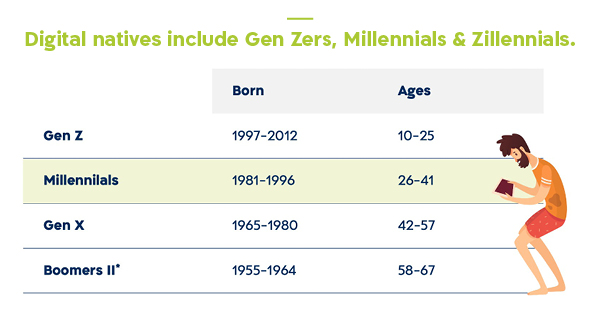 The millennials, also known as Generation Y, were born after 1980. They are now in their 30’s. Generation Z, as you can see in the table, is still young, but we will soon see them influencing our businesses. Since technology is changing very quickly, a sub-generation was born between the Millennials and Generation Z. Zillennials were born between ‘93-‘98 and were influenced by more advanced technology than the Millennials.
For their entire lives, digital natives have been surrounded by technology, social media, mobile devices, computers, and the internet. They speak this digital language as their mother tongue. They did not learn this language in their 20’s, 30’s, or later. They do not have an accent, so to speak.
The millennials, also known as Generation Y, were born after 1980. They are now in their 30’s. Generation Z, as you can see in the table, is still young, but we will soon see them influencing our businesses. Since technology is changing very quickly, a sub-generation was born between the Millennials and Generation Z. Zillennials were born between ‘93-‘98 and were influenced by more advanced technology than the Millennials.
For their entire lives, digital natives have been surrounded by technology, social media, mobile devices, computers, and the internet. They speak this digital language as their mother tongue. They did not learn this language in their 20’s, 30’s, or later. They do not have an accent, so to speak.
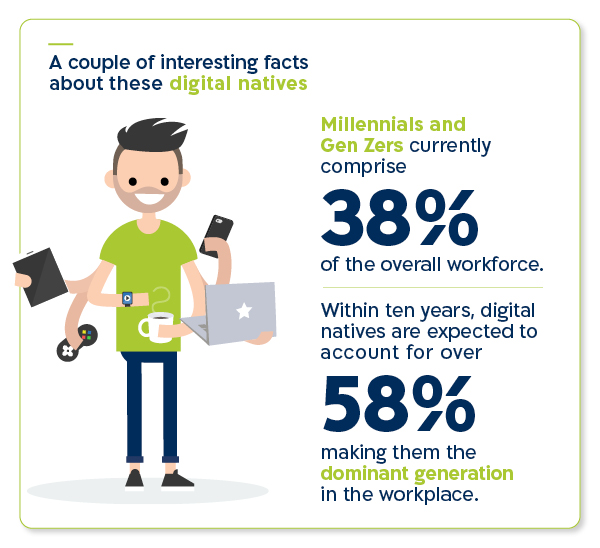
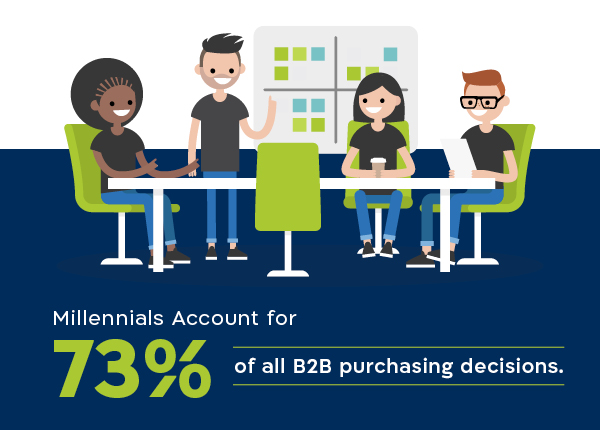 This impressive figure tells the whole story: More and more millennials and gen zers are entering the B2B decision journey, some as technological or professional influencers and others as decision-makers. It is important to note that among the people involved in decision-making, you usually meet several generations.
A few months ago, we at Oz Global B2B did a project for the American agricultural market. The intergenerational integration in the decision-making process that arose there was very prominent.
This impressive figure tells the whole story: More and more millennials and gen zers are entering the B2B decision journey, some as technological or professional influencers and others as decision-makers. It is important to note that among the people involved in decision-making, you usually meet several generations.
A few months ago, we at Oz Global B2B did a project for the American agricultural market. The intergenerational integration in the decision-making process that arose there was very prominent.
-
- A family business where the younger generation initiates a decision, and the founding generation approves it. Sometimes the founder initiates the decision but immediately passes it on to the younger generation to check online what the options are.
- A senior manager at a big business closes a deal, but the people in the field - professionals or salespeople - do not “speak” the same language. This will greatly affect the next purchase.
The Millennials and Gen Zers highly influence who will enter the decision funnel
About 50% of all product searches on the web are conducted by digital natives. The customer journey is long, complex, and involves many stakeholders.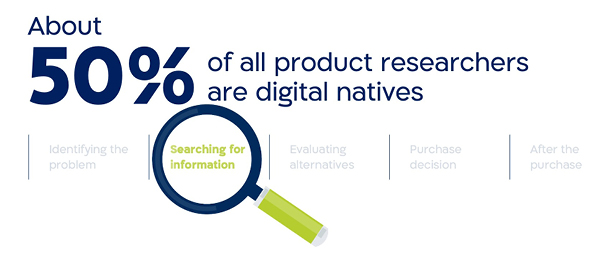 By the time the customer recognizes that he has a problem, we are, in most cases, not there. Identification is an internal stage from which someone is appointed to start researching information to find options for a solution.
50% of those who conduct the research and seek alternatives regarding a product or service, may not take an "official" part in decision-making but are the ones who put the relevant suppliers in the decision-making funnel. They are the ones who build the long list. They are the ones who decide whether or not you will be included in the “consideration group,” which is of critical importance.
By the time the customer recognizes that he has a problem, we are, in most cases, not there. Identification is an internal stage from which someone is appointed to start researching information to find options for a solution.
50% of those who conduct the research and seek alternatives regarding a product or service, may not take an "official" part in decision-making but are the ones who put the relevant suppliers in the decision-making funnel. They are the ones who build the long list. They are the ones who decide whether or not you will be included in the “consideration group,” which is of critical importance.
Two tips to gain the trust of digital natives:
1. Be authentic!
The generation that grew up on social networks, fake news, and unfounded marketing does not believe in marketing messages and does not believe in unproven statements. They have developed a hypersensitivity to online messages - they suffer from a blatant lack of trust in what is being said online. They continue to consume information online, but with a very large firewall. The bright side of it is that digital natives recognize authenticity when they see it..So what does authentic marketing look like?
-
- Get your executives to use social media Customers want to know the people behind the executives or the company representatives that they are in contact with.Make sure your site reveals who you are beyond your formal title. What topics do you choose to share? Who are your friends, what groups do you belong to, and to whom do you respond to?LinkedIn is not everything. Feel free to diversify to other social networks - Facebook, Instagram, Twitter, and even Tik Tok.
- Share user-generated content from real people Show real things, with real customers behind them. If you trust your product, let it tell your story.
- Go live on social media platforms Talk without filters. To digital natives this sounds obvious, to digital immigrants, it is less trivial. At first, the digital immigrants posted posts after editing them numerous times. Then they agreed to post an edited video. The transition to live video is scarier, but this is exactly the meaning of authenticity.
- Promote employee advocacy Empower your employees to share smart, quality content with their own social networks. On average, employee networks have 10x more connections than a company has followers. Plus, according to the Edelman Trust Barometer, people are 3x more likely to trust company information shared by an employee than that shared by a CEO.
2. Consumerize!
This word does not exist in the dictionary yet but already stars in the literature that follows trends in the B2B world. As Mona Akmal, Falkon CEO and Cofounder, once said, “As work and life flexibly intertwine, so must our approach to reaching our target users.” Gone are the days when the customer was a business person between 9-17 and a consumer on evenings and weekends. Studies show that the business customer is very much influenced by his consumer experience and expects to have a similar experience in business purchases. The customer experience touches on all stages of the journey - collecting information, placing an order, contacting the company up to paying.- More than 80% of B2B customers stated that they will look for a new supplier if their expectations in terms of customer service and user experience are not fulfilled.
- According to McKinsey & Co, B2B brands score below 50% on customer experience index ratings on average, compared to 65 to 85% for typical B2C brands.
- Gartner illustrates that 77% of B2B buyers report that their last purchase was very difficult or complex.
To sum up…
- The digital natives are digital animals. They were born into it, and it is their playground. It requires us to be present and comfortable in the digital space. Allow them to find us easily and learn about us in a convenient way that interests them. Allow them to easily consult, purchase and pay online.
- Life in the digital arena has taught them to be suspicious, not to believe everything they are told. They have developed the skills and expertise to recognize fake news when they see it. This requires us to be authentic in interactions with them, without filters and edits.
- Remember, before they are decision-makers, customers, or partners, they are first and foremost human beings. Their personal lives have seeped into their business life and it is very difficult for them to separate the two. So, we have no choice but to "consumerize" the way we treat them.
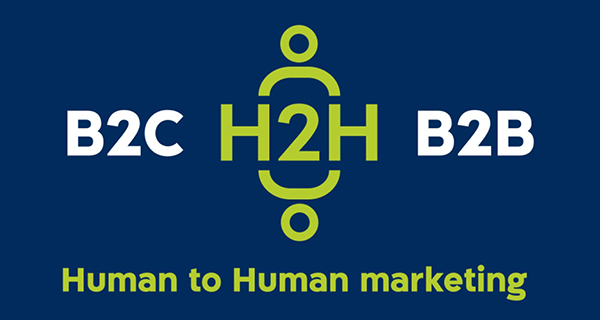
HUG Haifa – SALES & MARKETING ALIGNMENT
By
Jonathan Cohen
, 08/08/2019
The HUG Haifa debut was a triumph. We gained insights from HubSpot's Stephen Fuery and BERMAD's Ofir Marx, which will advance our Marketing and Sales projects.
- 87% Of the terms sales & marketing use to describe each other are negative
- 20% - The amount of revenue increase companies with strong sales & marketing are able to achieve.
- I don’t know if the sales team is working my leads
- I don’t know the ROI of my marketing campaigns
- I’m getting too many leads and can’t prioritize them
- I don’t know what to do with these Marketing leads.
Service Level Agreement (SLA)
This is a commitment between Marketing & Sales to deliver on specific goals. How do you create an SLA? Glad you asked 😊. Use Historical data to understand your goals, putting into consideration the common goals between the two teams. Ask yourself these questions as a roadmap to creating an SLA that serves both the marketing and sales teams:- How many MQL’s is Marketing creating?
- Are Sales working MQL’s?
- At what rate are MQL’s converting to Customers?
- What % of deals are attributed to Marketing?
Decide on future SLA’s and build reports to measure them, presenting SMART (Specific, Measurable, Actionable, Relevant, Timely) goals.
Let’s compare: Goal 1: I want more website visitors, leads and sales. But this is too general, what about? Goal 2: I need 20,000 visitors, 500 leads, 12 customers within 12 months in order to achieve our revenue goal of $600,000 from Inbound. Goal 2 is a SMART goal. It will give you a complete picture of what you want to achieve.Agree on Fit
This is a measurement of how well you could serve a lead if they were to become a customer.Segmentation:
Let’s divide segmentation into two parts:- Lifecycle stage: a way of categorizing where any given contact or company is within your marketing and sales flywheel.
- Lead Scoring: Lead scoring is a methodology used by sales and marketing to determine the worthiness of leads or potential customers by attaching values to them based on performance.
- Publishing professional blogs, case studies, and white papers
- Sending out nurturing emails to leads
- Posting on social media
- Using marketing automation to convert a lead to SQL
- Increase involvement in LinkedIn discussion groups
- Target campaigns in specific locations
- Blog in other languages
- Introduce Account Based Marketing activities.
Can Inbound Marketing Really Impact on Your Bottom Line?
By
Orit Oz
, 08/03/2019
Bermad, a kibbutz-based company manufacturing water control valves, built itself into a successful global concern from the ground up.
The conversation has changed: From top down to two-way communication
“Today, we can communicate directly with customers,” says Marx. “In the past, our way of communicating with customers was top down. HQ communicated to its subsidiaries, who communicated to the dealers, who in turn, communicated to the end users. We never got direct feedback, and even if we did, it had passed through three to four different hands and got filtered along the way. That’s changed. Now by publishing blogs, case studies, and white papers, sending out emails, and posting to social media, we have the ability to deliver messages directly to the end user and get feedback.“
Generating leads, assessing quality
Leads are collected on landing pages with targeted calls to action (CTAs). By asking qualifying questions, Bermad is able to assess the quality of the leads received. The results show that 35% are sales qualified leads (SQL), 30% are marketing qualified leads (MQL), and the balance are service requests, spare parts or vendors looking to sell the company something. In short: More than 60% leads are relevant enquiries.Key goals versus results
At the beginning of the process, Bermad set some goals:- Increase site traffic to 20,000 Moved from 12,000 to 20,000 website visitors per month in less than 2 years
- Generate 500 leads per month Approximately 200 leads per month now and it’s rising
- Added Revenue of $1,000,000 per year Reached $700,000 in 2017; anticipate higher in 2018
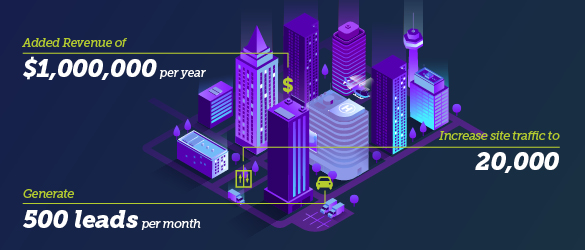
Are we getting it right?
The ability to speak directly to the marketplace and understand what they are interested in and what questions they ask, enables the company to understand whether they need to do anything differently.What’s next?
Marx believes that the awareness and exposure that is being gained is very important, and it’s only the beginning. There’s still much to be done, from increased involvement in Linked In discussion groups to targeted campaigns in specific locations, as well as blogging in other languages such as Spanish and Portuguese.Leveraging the power of marketing automation
The company is just beginning to benefit from the powerful marketing tools available on HubSpot including lead scoring and nurturing. Having tripled the amount of contacts, there is a wealth of potential customers to cultivate, taking them from the awareness and consideration stages through to making the decision to purchase.It takes time, effort and investment
Today, all Bermad’s divisions are involved, with 4-5 people at HQ contributing to content creation as well as support from professionals at the company’s various subsidiaries. Blogs are published on a monthly basis for all four segments (waterworks, irrigation, fire protection and building & construction), supported by email blasts, newsletters and ongoing social media posts. Campaigns are run to support product launches, exhibitions and special events. All marketing activities are integrated into Bermad’s CRM system, allowing the sales team to see a 360° view of potential customers and enabling them to close more deals. “Today, nobody asks why we are doing it,” notes Marx. “We’re just beginning to see the benefits.”How To Grow Your Business Using the Flywheel
By
Ilan Amit
, 23/01/2019
That’s when the real growth happens.
 Simply put, the top of the funnel (TOFU) is where you build awareness about your company and the problem you address, the middle of the funnel (MOFU) is where you teach people how to choose a solution, and the bottom of the funnel (BOFU) is where you explain why your product is the best solution.
The funnel has a major weakness: It doesn’t take into account that the people coming out of the bottom of the funnel can have a major impact on the people going into the top of it — in fact, people at the bottom of the funnel can feed those going into the top of the funnel.
Conversely, the people leaving the bottom of the funnel can prevent other people from entering the top of the funnel.
Simply put, the top of the funnel (TOFU) is where you build awareness about your company and the problem you address, the middle of the funnel (MOFU) is where you teach people how to choose a solution, and the bottom of the funnel (BOFU) is where you explain why your product is the best solution.
The funnel has a major weakness: It doesn’t take into account that the people coming out of the bottom of the funnel can have a major impact on the people going into the top of it — in fact, people at the bottom of the funnel can feed those going into the top of the funnel.
Conversely, the people leaving the bottom of the funnel can prevent other people from entering the top of the funnel.
 The attitude of people when they come out of your funnel has a direct impact on the number of people who are willing to enter the top of the funnel.
The attitude of people when they come out of your funnel has a direct impact on the number of people who are willing to enter the top of the funnel.
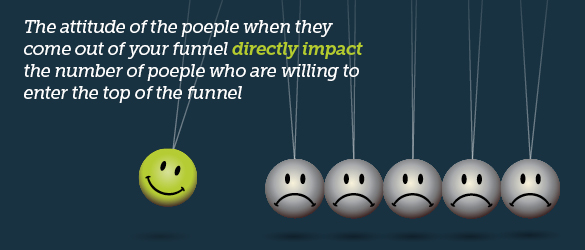
The Flywheel as a Growth Engine for Your Business
Funnels produce leads. What they don’t do is help you close the leads, keep your customers happy, or take advantage of the customers you’ve already acquired to help you grow. That’s where the flywheel comes into play and the inbound marketing methodology helps it spin.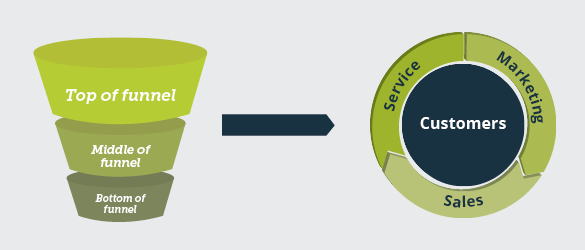
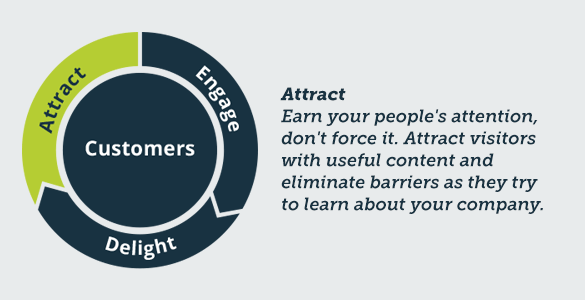 The rotating flywheel represents the growth of your business. Happy customers help fuel your growth. How? By buying from you again, or bringing new customers to you by promoting your product to their extended network of colleagues, friends or family.
“The rotation of the flywheel represents the growth of your business, and happy customers provide the energy that fuels that growth.”
Kyle Jepson, Hubspot Academy
All your marketing activities should be focused on creating customers who will inject good energy into the flywheel and speed up your company’s growth.
The rotating flywheel represents the growth of your business. Happy customers help fuel your growth. How? By buying from you again, or bringing new customers to you by promoting your product to their extended network of colleagues, friends or family.
“The rotation of the flywheel represents the growth of your business, and happy customers provide the energy that fuels that growth.”
Kyle Jepson, Hubspot Academy
All your marketing activities should be focused on creating customers who will inject good energy into the flywheel and speed up your company’s growth.
Combining Funnels and Flywheels
While the flywheel represents your company as a whole, funnel charts can help you improve a particular aspect of your business performance, for example, your sales funnel. Analyzing it can help you understand where you’re losing customers along the way. When your entire company starts thinking about accelerating the flywheel as a whole instead of focusing on improving individual funnel metrics, major strides can be made. That’s when the real growth happens.It’s all about the people and building relationships
By
Miri Peled
, 09/08/2017
We worked together to develop a new visual identity that stands out in the global market and is also centered around Trendlines’ two foundational principles.
It’s about the people AND building relationships
Because Trendlines Group’s hands-on investment approach and commitment to improve the human condition through innovation are inseparable parts of the company's character, the refreshed visual identity rests strongly on these principles. The result – a new compelling brand and visual identity – was launched at Trendlines’ 7th Annual Trendlines Company Showcase attended by hundreds of biomedicine industry professionals from around the world, and sponsored by companies worldwide.Inbound for Medical & Healthcare Companies Event
By
Miri Peled
, 23/07/2017
We held an Inbound for Medical & Healthcare Companies event where industry experts shared multiple insights on marketing for medical and healthcare industries.
- Matt Brown, HubSpot Specialist from Boston – US Trends in Healthcare Marketing
- Dina Gidron, VP Strategy at OZ – Opening New Channels of Communication
- Mickey Nave, Corporate Marketing Director at Lumenis – Medical marketing: generating leads that your sales team will love
- Bat-chen Grinberg, Founder of MC Forum – Digital tools that reduce your work overload
- The age of “Social Health”. The combination of healthcare reforms, the age of consumerism and mobile technology is creating the perfect climate for change in healthcare.
- We see YOU, we know YOU, we understand YOU, we want to help YOU. The digital revolution is transforming the way we do business as we shift from a Business-to-Business (B2B) to a Business-to-Business-to-User (B2B2U©).
- Patient-consumers are the center of the universe. As patient-consumers become the single most important factor in this new era, we need to open up direct channels of communication with them to understand their challenges, increase brand awareness and create bottom-up demand.
- Trends in medical and healthcare. Patient-consumers are avid researchers; marketers are targeting patient-consumers AND payers; digital channels are overtaking traditional marketing channels; and digital content is key to the decision process.
- Brands must recognize social health and deliver value across the full spectrum to drive leads, convert prospects to customers and keep them loyal.
- Inbound marketing and content marketing are well-suited to the medical and healthcare industry as it promotes targeted communication, trust-based decision-making, long-term relationships, and thought leadership and industry expertise.
Getting to know your patient-consumers
By
Orit Oz
, 13/07/2017
When I just started my career, an intelligent woman told me that only when I understand.
Preparing for the age of “Social Health”
As healthcare reforms, the era of consumerism and mobile technology create the ideal climate for positive change in the medical and healthcare arena, we’re ushering in a new age – the “Social Health” era. As we transition into this new era, patient-consumers are becoming the single most important factor in the medical and healthcare eco-system; and as they research and shop online for medical services, products and insurance plans, the medical & healthcare industry increasingly resembles a retail industry. The impact of this shift on medical and healthcare providers is huge as it means they need to open up direct channels of communication with patient-consumers to understand their challenges and offer services and products with real value. Or in other words, there is a need to move from a Business-to-Business (B2B) to a Business-to-Business-to-User (B2B2U©) approach. As we enter this age of “Social Health”, brands need to recognize the need to deliver value across the full spectrum to drive leads, convert prospects to customers and keep them loyal.
As we enter this age of “Social Health”, brands need to recognize the need to deliver value across the full spectrum to drive leads, convert prospects to customers and keep them loyal.
What’s the difference between traditional and inbound marketing?
By
Miri Peled
, 29/06/2017
Inbound marketing focuses on attracting customers through valuable content, while traditional marketing is marketer-centric and uses more interruptive methods.
It's time to attract your prospects instead of bombarding them.
Inbound marketing is a customer-centric approach that focuses on attracting customers to your business through content and interactions that are valuable, helpful, and trust-building.It’s all about using remarkable content to develop and nurture long-term relationships with your prospects so they ultimately build trust in your brand.
In comparison, traditional marketing, which is marketer-centric, uses more interruptive methods to vie for the attention of prospects.| Inbound | VS. | Outbound | |
| Definition | Inbound marketing uses customer-centric tactics to attract prospects, address their challenges and goals, and build trust in your business | Traditional marketing uses more interruptive methods to push products and services and get the attention of prospects | |
| Communication | Based on interactive communication that engages prospects and attracts them to you | Based on one-way, outward communication | |
| Tools/techniques | Educational content such as blogs, videos, eBooks, white papers, SEO, and case studies | Print and TV ads, banner ads, direct mail, cold calling, and mass email campaigns | |
| Goals | Offer prospects value through educational content and earn their trust | Drive sales through product-centric marketing |
Get your creative juices flowing with these great blog topic tips
By
Orit Oz
, 06/06/2017
Here are some tips to get your creative juices flowing to come up with some great blog topics.
- Consider the content’s purpose, format and topics.
- Create content that builds trust amongst your prospects.
- Get your content in front of the right people at the right time.
- Analyze & repeat. Determine what worked and what didn’t, and repeat your successes.
What is lead nurturing?
By
Orit Oz
, 24/05/2017
Lead nurturing is the process of engaging with contacts via automated workflows to build a relationship with them.
- Grow and nurture relationships
- Offer educational content
- Use hyper personalization
Inbound marketing in a nutshell
By
Orit Oz
, 16/05/2017
When I just started my career, an intelligent woman told me that only when I understand.
Why inbound marketing?
We live in an age where people are bombarded with advertising wherever they turn, and for this reason, have become increasingly skeptical of standard interruptive marketing methods. In fact, Harvard Business Review reports that 90% of B2B buyers never respond to cold-marketing. For this reason, instead of competing for consumer attention, inbound uses the fact that prospects seek out the information they need on their own terms. By developing valuable and relevant content with the expectation to be found, potential customers will come to you, become new clients, and ultimately be delighted by their experience.How does inbound marketing work?
Inbound marketing is based on four phases: attract, convert, close, delight
ATTRACT
First, attract visitors to your website using tools such as blogging, website optimization, and, social media. Tools: blog, social media, keywords, pagesCONVERT
Once you have new visitors, you can convert some into leads by gathering their contact information, the currency of inbound marketing. To do this, it's important to offer them something valuable, usually in the form of additional information or useful content. Tools: calls-to-action, landing pages, forms, contactsCLOSE
Once you’ve converted some visitors into leads, you need to nurture their interest by providing them with relevant information. In this stage, tools like email and CRM are helpful in selling to the right leads at the right time. Tools: email, workflows, lead scoring, CRM integrationsDELIGHT
Once you close a sale with a customer, your relationship is just beginning. At this stage, you need to continue to delight and engage them so they become happy promoters of your brand. Tools: social media, smart calls-to-action, email, workflows Analysis is critical to making inbound marketing work. Every strategy and technique you use, and content you create, should be analyzed regularly to see if it's working, and adjusted as needed to make it better.Does inbound marketing work for B2B?
By
Orit Oz
, 16/05/2017
Does inbound marketing work for B2B businesses? Of course it does, because it doesn’t matter what you’re selling or to whom – your customer always comes first.
Attracting customers with inbound marketing
Inbound marketing is a customer-centric approach that focuses on attracting customers to your business. Unlike traditional interruptive marketing that vies for attention through cold calls, purchased ads, and email blasts, inbound marketing responds to prospects’ needs and interests by offering them valuable content in the right place and at the right time. “By publishing the right content in the right place at the right time, your marketing becomes relevant and helpful to your customers, not interruptive.” - Hubspot Read more about inbound marketing here.So how does inbound marketing work for B2B?
It’s often assumed that inbound marketing is better suited for businesses that sell directly to consumers (B2C); and, in the recent “push” to “pull” marketing shift, it appears that B2C organizations have more easily adopted this new marketing model. In contrast, B2B or B2C organizations appear to be more skeptical and adopt the new approach with more caution. The main reason for this is that a lot of B2B and B2B2C organizations are still trying to figure out how inbound marketing can work for them; and they often question whether this new approach is even applicable to business customers.The answer is — of course — YES!
Because the truth is that it doesn’t matter what you’re selling or to whom, the majority of your prospects are usually partially through the buying cycle before they even consider talking to a salesperson. And that’s where the emphasis needs to be — ON YOUR PROSPECTS. In order for inbound marketing to work, you need to have an in-depth understanding of your value chain and your sales model. Once you have that, you can then create valuable content that attracts visitors to your business, converts them into prospects, engages them until they decide to purchase your product or service, and then delights them so they become promoters of your brand. In this manner, you can use inbound marketing to create a win-win situation where you get closer to both your distributors and your end users, and in the process, increase brand awareness to enhance end-user demand for your brand (even if you they are not buying directly from you). But here’s the thing – you need to be in it for the long haul. Inbound marketing takes time, effort, and patience. But it’s definitely worth the wait!Attracting the RIGHT customers to your B2B business
By
Orit Oz
, 16/05/2017
Inbound marketing for B2B is about attracting the right people to your business – those who become leads, then customers and ultimately promoters of your brand.
The power of content in inbound marketing
By
Orit Oz
, 16/05/2017
Content is the fuel behind inbound marketing – it carries the message your company wants to deliver to your customers at the right time and in the right place.
Content is what sets you apart
It’s the fuel behind inbound marketing – it carries the message your company wants to deliver to your customers at the right time and in the right place. It’s what powers a successful inbound strategy by pulling people from one stage of the inbound methodology to another and addressing their challenges and questions.Content in B2B
Content marketing works for every type of business. In fact, according to a report put out by the Content Marketing Institute, 85% of B2B marketers identified the creation of quality and efficient content as being a leading factor for increased marketing success in 2016. Additionally, based on company metrics, 78% of these B2B marketers report an increase in audience engagement and 57% saw an increase in sales with use of content for their B2B marketing.The content process
Now that we've established the importance of content, where do you start and what should you focus on? The best way to optimize your content for your inbound marketing strategy is to follow a content process that involves 4 main steps:- Consider the content’s purpose, format and topics.
- Create content that builds trust amongst your prospects.
- Get your content in front of the right people at the right time.
- Analyze & repeat. Determine what worked and what didn’t, and repeat your successes.
How can the digital revolution help you extend your reach?
By
Orit Oz
, 15/05/2017
As technology rocks our world, we need to get closer to our customers, understand their customer journey, and adjust our marketing and sales accordingly.
This means that before you do anything else, you need to identify, understand and talk to your customers.
This involves meeting customers at different points on their journey, mapping their journey and fully understanding their needs. Once you’ve done this, you can go on to define your potential buyer personas; identify how you meet their needs, motivations, pain points and challenges; create relevant offline and online content and tools to communicate with them; reallocate marketing and sales (and other) resources to match the real needs of your customers; and create collaboration between your marketing and sales (and other) teams. But first, get to know your customers! From there, the rest will follow.Getting creative in B2B marketing
By
Miri Peled
, 15/05/2017
Yes, branding is vital to success. But what about lead generation, which is also crucial to business and requires creative methods to bring in qualified leads?
What’s all the fuss about Inbound marketing?
By
Orit Oz
, 15/05/2017
We’ve all heard the term Inbound marketing thrown around a lot lately. It’s become the latest catchphrase in a field that’s already packed with catchphrases.
What is Inbound marketing?
Inbound marketing is the process of attracting potential customers and getting them to reach out to you. This is different to more traditional marketing (also known as push marketing or outbound marketing) where you actively reach out to potential customers through methods such as cold-calling, printed magazines, and traditional advertising. But how do you attract potential customers and get them to trust you before you’ve even pitched them your product? The answer lies in content —the foundation of the Inbound methodology. By creating carefully curated content, you’ll establish yourself as a trusted source of knowledge and attract the ideal visitors to your site, convert them into leads and then customers, and keep them engaged so they go on to promote your brand. “By publishing the right content in the right place at the right time, your marketing becomes relevant and helpful to your customers, not interruptive.” - Hubspot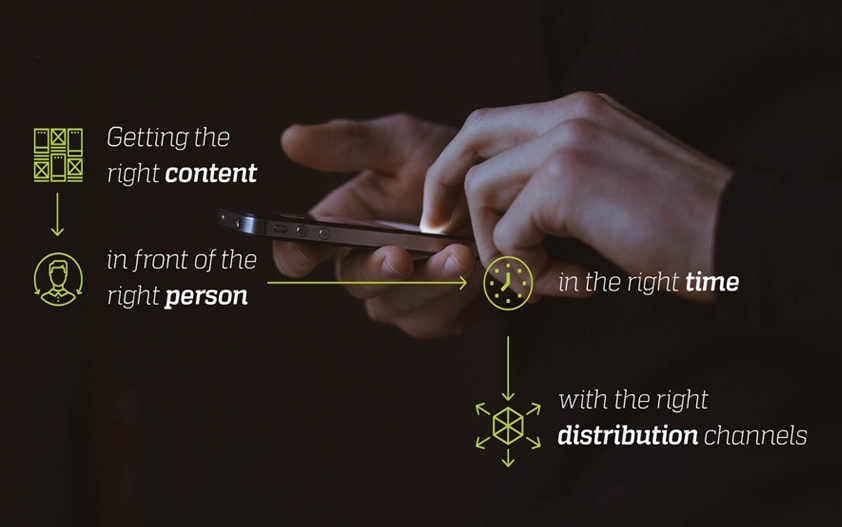
Inbound marketing in a nutshell
Inbound marketing is filled with complexities, but the following four steps (based on the Hubspot Inbound methodology) summarize the main Inbound stages:- Attract. Before you do anything, you need to fully research and understand who your ideal customers or buyer personas are. Once you have identified them, you can get them to come to you.
- Find creative ways to “convert” these potential customers into leads by offering them something valuable in return.
- Turn your leads into customers.
- Continue to engage with your customers so they become promoters of your brand.
Inbound marketing in B2B
At this stage, you may be wondering whether Inbound marketing works in the world of B2B. The answer is a big loud “Yes!” In fact, Inbound marketing creates a win-win situation for you where you can get closer to your direct customers and distributors, and also increase brand awareness amongst end users to enhance end-user demand for your brand (even if you they are not buying directly from you). Read how Elcam used digital marketing to increase brand awareness>>Combining Inbound and offline marketing
We’d like to emphasize that Inbound marketing does not replace the need for interpersonal interaction with your customers – especially in B2B industries where the customer model tends to be more complex and is often based on long-term relationships. The goal is to find the right communication mix for your specific B2B business needs, market and customers. By promoting your brand through a digital dialog and an inter-personal dialog, you can achieve a more effective and efficient sales and marketing process for better business results. For example, you can combine a compelling digital campaign to encourage potential customers to visit you at a trade show, and then meet them at the event to continue a direct dialogue with them. Look out for our next blog post on the need for face-to-face communication with your customers and creative ways to combine digital and interpersonal communication (coming soon).Inbound marketing – here to stay?
Another big loud “Yes!” It’s quite simple - as more and more potential buyers turn to the Internet for answers to their challenges, they look to buy from suppliers who instill trust by answering their questions and offering solutions to their problems. This means that in order to stay relevant in the marketplace, you have to be present where your potential buyers are looking for answers - online. And that’s why everyone is fussing over Inbound marketing.Should I Still Speak to My Customers Face-to-Face?
By
Miri Peled
, 14/05/2017
Are you struggling to find the right marketing mix? Get some tips on creating an offline marketing strategy that is complemented by your online strategy
Integrating online and offline marketing
With all of this focus on online marketing, we tend to think that we should invest all of our energy in our online presence. But it’s not that simple as customers don’t only spend their time online. While online marketing is crucial to growth and success, you need to also engage your customers using offline methods – especially in B2B industries where long-term relationships with customers are crucial to success. A good way to understand this is to compare it to the use of social media in our personal lives. Most of us frequently share personal information about ourselves, our families, our hobbies, and more, on social media platforms. Despite the fact that these platforms seem to “replace” direct relationships, that’s not usually the case, and most of us still make a lot of effort to meet with our families and friends on a regular basis to nurture our inter-personal relationships. If we apply this example to business, we can build well-balanced marketing strategies by combining the use of social platforms to share knowledge with potential customers and build their trust, with inter-personal, offline interactions.
Not mutually exclusive
Using both online and offline marketing doesn’t mean that you need to create separate strategies for each. Instead, you need to create the right marketing mix for your company and field where your offline marketing strategy is actually complemented by your online strategy, and vice versa. Here are some examples:1. Trade shows
Trade shows may be traditionally associated with “offline” marketing, but you can leverage your investment in them by using a digital strategy to promote your company’s presence at the event. This can be done through digital ads, social media campaigns, landing pages, calls-to-action, and even webinars or videos talking about the upcoming event and where to find you. These promotions can be used to both promote your business in general, and to set up meetings or collect quality leads.At the event, you’ll be able to meet these potential customers (and other) face-to-face and most importantly, to follow up after the event based on what they told you about their specific needs. Again, the follow-up communication can be done through both direct communication and digital communication such as newsletters.
Read here about the online approach to event marketing>>
2. Samples to customer
Offer potential buyers and distributors that leave their contact details via digital platforms free samples of your products (where relevant) or promotions. In this manner, you can collect quality leads from customers, communicate with them directly to get them to try your products, and continue to engage with them through online campaigns. You can also use geo-driven campaigns to attract potential buyers and then refer them to local points-of-sale.
3. Digital campaigns and demos
Use digital campaigns and landing pages to encourage potential buyers to leave their information and then call them to set up a live demo of your product. You can continue to nurture the relationship with these potential buyers after the demo through a combination of offline and online marketing techniques.
4. Join social media groups
Join and contribute to social media groups in your field, use them to increase your brand awareness, and look out for offline networking initiated by these groups, including impromptu meet-ups and offline conversations. You can also initiate such offline events in order to meet potential leads face-to-face.










